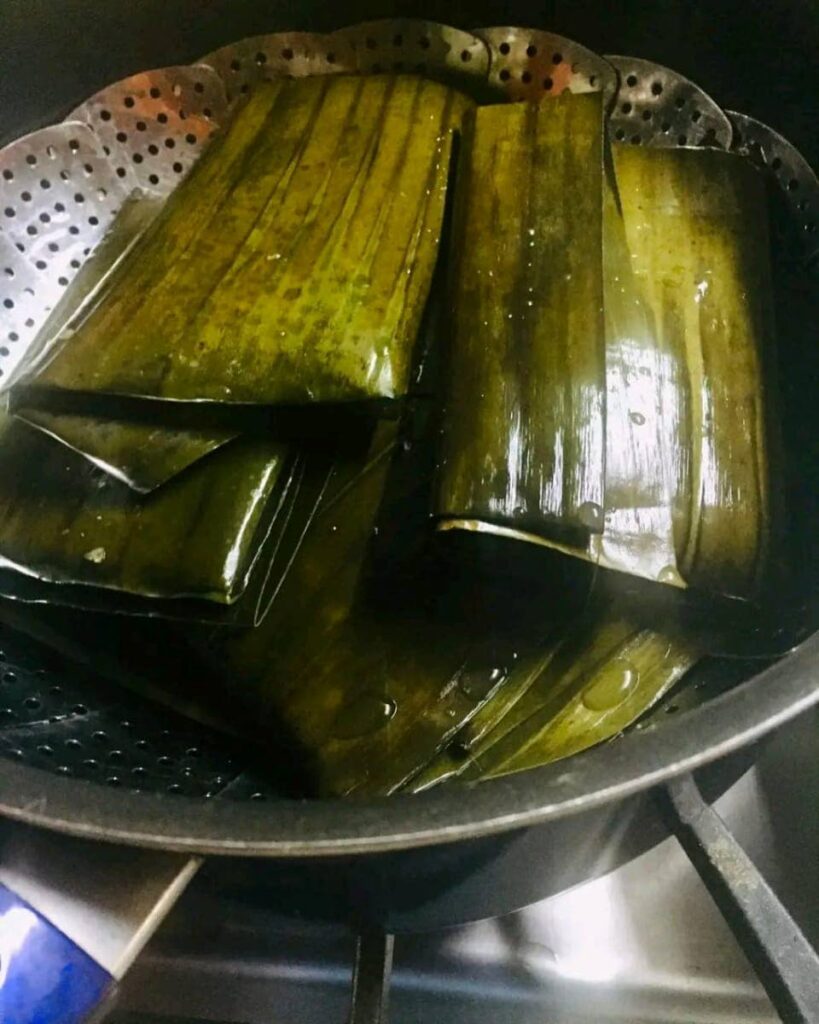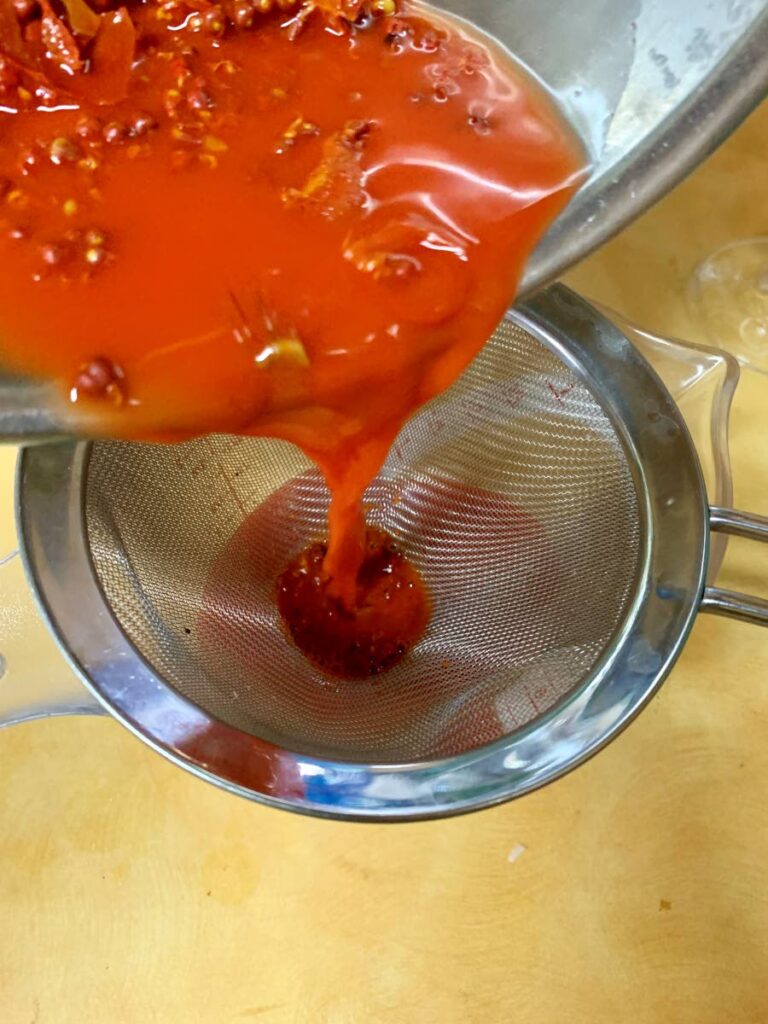Let’s make pastelles

It’s that time of the year when friends gather to make pastelles for the Christmas season, or am I dreaming? Do we still gather to cook? I’m not sure. I think many people order enough pastelles to last the season. It’s a dwindling tradition and a sad situation, because the commercial pastelles are a far cry from the homemade version, with many opting in the name of profit to omit the raisins, capers and olives which contribute to its identity and use a simple smear of filling, in a sometimes dry cornmeal package.
I make my own pastelles, I don’t make hundreds, a few dozen suffices me through the season, but I am particular with the taste and the ingredients. If I am making a pure chicken filling I will bone a whole chicken in order to have a good balance of dark and light meat. For full flavour, I use lots of fresh herbs, no artificial flavourings and I use butter in my cornmeal dough and some roucou to enhance colour.
I can control the quality of ingredients I use in my filling but I can’t control the quality of cornmeal for the dough. Recently I found my cornmeal dough very bland and the texture dry. Not the usual smooth texture and delicious corn flavour which I, and many others, have become accustomed to for most of our pastelle eating years. Until a friend turned me to another brand of cornmeal, not the usual brand that has become a household name on our island. I was so disappointed in that regular brand that I tried the new Donarepa brand that was recommended. And I was not disappointed.
I made corn arepas, cornbread, polenta and coo-coo, the new cornmeal brand gave me that “sweet” and smooth quality that I want. So this year I certainly will enjoy my pastelles again using the Donarepa cornmeal, which is manufactured from Columbian-grown corn in Columbia. Do you know why the other cornmeal has become so inferior in my humble opinion, in both taste and texture?
It is now made in the USA. So the lesson here is don’t be afraid to switch and try new brands. Don’t take it personally when your recipe disappoints, it’s not you, it could be the quality of your ingredients.
Cassava pastelles
1 recipe master pastelle filling (see below)
Dough or masa
2 lbs peeled raw cassava
1 tbs roucou
1 tsp salt
2 tbs coconut or olive oil
12 banana leaves 12x12 inches, passed over a flame or steamed to soften.
Grate cassava or process in food processor until mushy, place into a towel-lined strainer, leave for about one hour to remove any excess water.
Place into work bowl, add roucou and salt. Mix well with a wooden spoon or with your hands.
Section the masa/dough into 12 sections.
Place one banana leaf onto your work surface, oil the leaf.
Place the cassava masa onto leaf, place another oiled leaf over dough and smooth the dough to a 6-inch circle.
Place 2 tbs filling onto the middle of the dough. Bring the top portion of the leaf over to cover ½ the dough, press with your finger to release the dough. Repeat with the bottom half, and then the sides, making a neat package.
Fold over a few times into a neat package, and repeat with other pastelles.
Steam for 20 minutes until cooked through.
These are best served warm. To reheat steam them do not microwave.
Makes 12.
Pastelle filling - master recipe
1 lb ground (or chopped) beef or chicken
1 tsp freshly-ground black pepper
1 tsp salt
1 cup chopped chives
¼ cup chopped fresh thyme
2 tbs olive oil
2 onions, finely chopped
4 cloves garlic chopped
2 pimento peppers chopped
1 tbs chopped celery
1 tbs tomato paste
2 tbs roucou
¼ cup raisins
4 tbs capers
3 tbs olives, sliced
2 tbs fresh thyme
Combine beef with salt and black pepper.
Add ¼ cup chopped chives and one tablespoon thyme.
In a large sauté pan heat olive oil, add onion, garlic and sauté until fragrant. Add pimento peppers, add remaining chive, pepper, and thyme, add meat and cook until brown.
Add tomato paste cover and simmer for about 15 minutes.
Add roucou and stir.
Add raisins, capers and olives and stir to combine.
Cook for about 5 minutes more, taste and adjust seasoning.
Add 2 tbsp fresh thyme and stir to combine. Remove from heat and cool.

Cornmeal pastelles
Cornmeal dough
2 cups Donarepa yellow cornmeal
2-2½ cups hot water
½ cup butter, softened
1¼ tsp salt
1 tsp roucou
12 banana leaves 12x12 inches, passed over a flame or steamed to soften.
Add butter to water, stir to melt.
Combine cornmeal with water mix. Add roucou.
Stir well and knead make a soft pliable dough.
Divide the dough into 15 balls of dough.
Cover with a damp cloth to prevent drying.
Place one piece of dough, (place some oil on your dough), on a greased fig leaf, and press to an 8-inch width.
Spoon two tablespoons filling onto the middle of the dough and fold and seal pastelles.
Wrap in fig leaf and tie into a neat package.
Steam pastelles for 45 minutes until cooked.
Makes 15 pastelles
Roucou

1 bunch roucou, about 20 pods
Remove the roucou/achiote seeds by opening each pod and scraping seeds into a bowl.
Sprinkle with salt.
Cover with about one cup hot water, let stand for a few hours to draw the colour from the seeds. Your liquid should be an intense orange red colour.
Strain into a glass bottle.
I usually refrigerate my roucou.
Makes 8 ozs.
rahamut@gmail.com


Comments
"Let’s make pastelles"